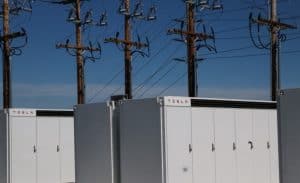
The white boxy structures across the river from the former Great Northern Paper mill in East Millinocket, Maine, don’t look like much from a distance. But a closer look offers a glimpse of Maine’s green energy future — one that’s battery powered.
Half a mile down a dirt road through the woods, you come to a clearing above a dam on the West Branch of the Penobscot River. Nine gleaming white cubes, each the size of a short shipping container, are sitting on cement pads. They generate a faint hum.
The boxes are marked with a red logo: Tesla. They are high-tech lithium ion batteries known as Tesla Megapacks.
“The total of nine megapacks together is 10.3 megawatts. But they can do that for two hours, so the capacity is actually 20.6 megawatt hours,” says Jamey Cole, an electrical engineer with Brookfield Renewable, which owns this battery system. “Each one of these obviously is DC, and they have an inverter which will convert it to AC which is what our grid is. From there it will get stepped up on a transformer, and the battery will go out at AC at 34,500 volts.”
That’s a lot of numbers, but the takeaway is that the Megapacks hold a significant amount of juice, enough to power about 9,000 New England homes for two hours. That’s the reason the batteries have been placed next to an existing substation that’s linked to Brookfield’s East Millinocket dam.
And they don’t just store renewable power when it’s abundant and save it for times when it’s not. Cole says it’s a bit more complicated.
“Ideally we would keep them about 50% charged, that way if they needed, the grid needed power we can put it out, or if the grid needed us to take power, we could put it in,” he says.
Cole says Brookfield can use the batteries to respond to the needs of ISO New England, which manages the regional electrical grid.
“It all depends on how we operate day to day. It may sit there and it may follow what ISO wants us to do; it might charge one minute and discharge the next. Or if the demand is there and we have the power, they may be asked to output power for the next two hours. It kind of goes day to day, depending on the grid needs,” he says.
In the best scenario, Brookfield could be paid to pull energy off the grid, when it is “negatively priced,” then sell it back when it has a higher value.
The corporation has another similar facility just up the road at the former mill in Millinocket. And it’s planning two more near its dams on the Androscoggin and Saco rivers.
Another company, NextEra, has a battery on Cousins Island in Yarmouth. These are some of the first sparks in a coming charge of battery power.
Chris Rauscher works from Maine for Sunrun, a national company specializing in solar and battery systems for residences. He is not involved in these large Maine battery projects, but he says, in general, batteries are sort of like bacon.
“Everything is a little better with bacon on it. And that’s true for the grid, everything is better with a battery attached. That’s whether we’re talking about homes or businesses that need backup power from a battery if the grid goes down, or renewable installations like solar and wind, the batteries can provide firming up, can provide energy at night when the sun isn’t shining on or when the wind isn’t blowing, or to provide all sorts of other services on the grid,” he says.
Battery storage is one part of a massive electrification project that will be increasingly critical as the nation weans itself from the fossil fuels that are the biggest drivers of climate change. The grid will be carrying more juice as more renewable power projects come online, and electricity replaces internal combustion engines in cars and other uses.
A bill signed by Maine Gov. Janet Mills in 2021 established a state goal of developing 300 megawatts of battery storage by 2025 and 400 megawatts by 2030.
State Rep. Mo Terry of Gorham sponsored a bill this year creating sales tax exemptions for battery storage developers, and directing the Governor’s Energy Office to explore other tax incentives for the industry.
Terry says a battery storage facility planned for her hometown is on an entirely different scale than those now operating in Maine.
“The storage facilities that we have right now are on the smaller size, 10-15 megawatts per facility, where the one that’s coming to Gorham is hopefully going to be up to about 150 megawatts of storage,” she says.
That proposed facility, Plus Power’s Cross Town Project, would be about 17 times the size of the Tesla system near East Millinocket. That’s about enough to power 150,000 Maine homes for two hours.
Back at the Tesla battery plant near the East Millinocket dam, Cole says not only are batteries like these becoming more abundant, the technology is evolving quickly.
“The size of the batteries now, the technology seems to be a lot better. Probably 10-15 years ago, they would have been three times the size of what it is now. They’re always developing the technology, and I would say there probably is coming something that will be a lot smaller in the future, that’s for sure,” he says.
But for now, these batteries sitting on a bank above the river in the North Woods, quietly breathing energy in and out, are state of the art, offering a small glimpse of the electrified future.
